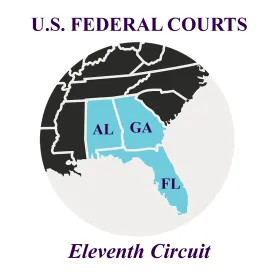The Eleventh Circuit’s opinion last month in FTC v. On Point Capital Partners LLC, et al., clarifies the ramifications of the Supreme Court’s ruling in AMG Capital Management regarding the prohibition of equitable monetary relief under Section 13(b) of the Federal Trade Commission Act (“FTCA”).
Section 13(b) of the FTCA authorizes the Federal Trade Commission to obtain a preliminary injunction and, in proper cases, a permanent injunction in federal court against any person, partnership, or corporation that the Commission believes is violating, or is about to violate, any provision of law enforced by the Commission.
But first, the Supreme Court decision in April 2021 . . .
On April 22, 2021, the Supreme Court held in AMG that the authority to obtain injunctive relief under Section 13(b) does not include the right to obtain equitable monetary relief, such as restitution or disgorgement. The Court described several considerations supporting this exclusion.
First, the Court noted an “injunction” is generally not the same as an award of equitable monetary relief.
Second, the statutory language and structure provide for prospective relief, not retrospective, and specifically relief to stop seemingly unfair practices from taking place while the Commission determines their lawfulness.
Third, other sections of the FTCA provide for conditioned and limited monetary relief. Section 5(l) authorizes district courts to award civil penalties against respondents who violate the Commission’s final cease and desist orders, and to “grant mandatory injunctions and such other and further equitable relief as they deem appropriate in the enforcement of such final orders of the Commission.” Section 19 authorizes district courts to grant “such relief as the court finds necessary to redress injury to consumers,” including through the “refund of money or return of property,” but only where the Commission begins its Section 5 process within three years of the underlying violation and seeks monetary relief within one year of any resulting final cease and desist order. As such, the Supreme Court found it “highly unlikely” that Congress would have enacted Section 13(b) to provide for a circumvention of traditional Section 5 administrative proceedings or for the same monetary relief without the conditions and limitations found elsewhere in the Act.
Accordingly, courts cannot award equitable monetary relief, such as restitution or disgorgement, under Section 13(b).
Now, back to the recent Eleventh Circuit decision . . .
Against this backdrop, the Eleventh Circuit examined a preliminary injunction previously imposed in 2020, which ordered an asset freeze, receivership, and an injunction against appellants making material misrepresentations of their services or from releasing consumer information obtained through their services.
The appellate court vacated the part of the order freezing appellants’ assets and placing a receivership over them, holding that such relief is unavailable under Section 13(b) because there is no longer a need to preserve resources for a future monetary judgment under that provision. The Eleventh Circuit, however, clarified that its opinion is limited only to the case on appeal and should not be construed as commenting on or having a legal effect on an asset freeze order in another case (FTC v. Acquinity Interactive, LLC, case no. 14-60166) with several of the same parties or their affiliates because that case was not properly before the court.
Also, the Eleventh Circuit announced the adoption of the Lanier Law test in determining whether a common enterprise exits under the FTCA for corporate entities’ actions. In an unpublished 2017 opinion, FTC v. Lanier Law, LLC, 715 F. App’x 970, the Eleventh Circuit had held a corporate entity can be responsible for the actions of other corporations in a business venture when “the structure, organization, and pattern of a business venture reveal a common enterprise or a maze of integrated business entities.” Lanier Law, 715 F. App’x at 979-80. The factors to consider include whether the businesses operated under common control, shared office space and employees, commingled funds, and coordinated advertising. Id. at 980. This test was previously adopted by the Sixth Circuit and now will officially apply in the Eleventh Circuit going forward.



 />i
/>i
